“I should make soup.”
Even if this is a sentence that’s never left your lips, let 2022 be the year of You Making Soup.
Why? Soup is a home for pretty much any leftover in your kitchen, plus you can reheat it over and over again. Using just one pot, you can win the battle against tight budgets and tight time frames!
But before you start rummaging and boiling, keep this in mind: Soup is not a “garbage pail,” says Rich Landau, chef and co-owner of Vedge in Philadelphia. Slightly wilted items are OK, but bad ingredients make for a bad dish.
Set your direction
Chances are you have garlic, but look at your herbs and spices and let those be a guide. Ginger might lead to Asian; basil, Italian. Cumin can go in many directions. Don’t hesitate to Google “recipes with … ” to see what plays well together, because you’re not limited to only one option, says Tiffani Faison, chef and owner of Big Heart Hospitality.
The key to making the best soup is to avoid surprises: Taste, taste and taste some more. “You want to understand where it’s going, where you want it to be, and what the final product is,” says Todd Ginsberg, chef and partner at The General Muir in Atlanta.
Lay the foundation
To make the stock, start by covering the bottom of a pot with oil or butter, and bring to medium heat. Soften at least an onion, preferably a carrot and celery as well, for at least 10 minutes. You want light-brown caramelization at the edges — no more than that.
If you have the remains of a chicken or turkey, remove any meat and set it aside. Then pull apart the bones and put them into the pot with just enough water to cover them, along with a smashed garlic clove, peel and all, if you have it.
Boil the stock for 30 to 45 minutes, skim the foam off the top, then boil it for another 10 minutes to reconstitute the fat.
Pour the stock through a strainer into a bowl or pot, and, if you have the time, let it sit for one hour, Faison says.
And now for soup
In the pot used for stock (wipe it out), again heat oil or butter, and add any remaining leftover vegetables. The tougher ones go in first, potatoes and carrots being the toughest. (If you’re short on veggies, the stock gets priority.)
When the vegetables start to soften, add your spices to release their oils. When they are fragrant, pour in the stock, followed by any already-cooked scraps, like the bits of meat or some beans.
The soup is ready when the toughest vegetable is tender and the flavor has been developed, Ginsberg says.
Finish with whatever fits: sriracha, tortilla chips, fresh herbs, a squeeze of lime. Any fat, like sour cream, chile oil or olive oil, can tie things together, Ginsberg says.
Whatever you add, at any point, start small. “You can always put in. You can’t take it out,” Faison says.
Sound like work? Yeah, a bit, but you’re creating something and wanting it to taste good. It’s not a speed event. “If you’re in a rush, open a can,” Faison says.

Travis Rathbone/Trunk Archive





